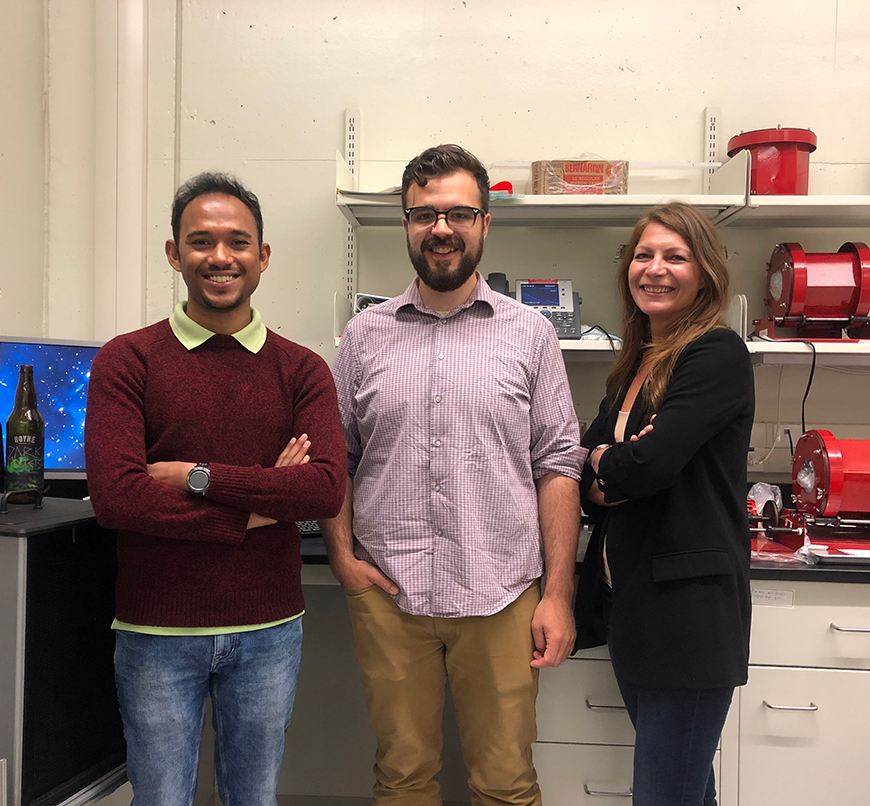
University of Alberta graduate students Sourav Sarkar and Daniel Durnford with assistant professor Marie-Cécile Piro in Dr. Piro's lab. The bottle of "Dark Matter" label beer on the left of the photo is empty (alcoholic beverages are prohibited from the lab). Dr. Piro discovered "Dark Matter" while on vacation in Jasper last year and has kept the bottle as a good omen. Photo by Suzette Chan.
Three University of Alberta particle physicists who attended the 2019 Canadian Association of Physicists Congress came back with honours and some new responsibilities.
Graduate students Sourav Sarkar and Daniel Durnford won honours for student presentations, while assistant professor Marie-Cécile Piro was named chair of the particle physics division for CAP, which held its annual conference at Simon Fraser University in Burnaby, B.C. this past June.
Sarkar, a PhD student supervised by professor Roger Moore, was making his first trip to CAP Congress. "It was pretty good," says Sarkar, who was able to meet with other particle physicists based at institutions. He was awarded first prize for in the best poster competition in the particle physics division, and went on to win first prize for best poster overall. Using data from the IceCube detector in Antarctica, Sarkar is looking for trident events, a type of neutrino interaction process. "The poster explores the IceCube detector, and what to expect when you see it, then it goes into the trident process, and future plans for the experiment," he says. Capturing trident events at IceCube would be huge. "It would provide a strong signature of physics beyond the standard model."
Fellow PhD student Durnford's oral presentation about NEWS-G placed second in particle physics. In contrast to neutrino experiments that use room-sized detectors (like SNO+ and DEAP), NEWS-G is developing much smaller (1.5 meters in diameter), spherical gaseous detectors. The NEWS-G detector is currently being tested in France's Laboratoire Souterrain de Modane (LSM), the location of the previous generation of the experiment. This fall, it will be moved to SNOLAB in Sudbury, Ontario, where it is expected to generate data at the beginning of 2020. Durnford's thesis, supervised by Piro, will focus on the resulting dark matter analysis and will cap his involvement in the experiment. "NEWS-G is a brand new experiment to the University of Alberta, but I worked on it as a Masters student at Queens University," says Durnford. "[The CAP honour] was really good exposure for NEWS-G, and great for starting conversations."
Piro was named the 2019-20 chair of the particle physics division for CAP. She will organize particle physics events at the next congress, including the student events. "I want to emphasize the role of the student at the conference," says Piro, who as a graduate student, won best oral presentation and best poster presentation at CAP Congress. She wants to use some of her budget to help more particle physics students attend the 2020 congress at McMaster University in Hamilton.
Piro, Durnford, and Sarkar all valued the chance to meet other physicists from across the nation. "This is a small conference (usually 650 to 800 delegates) compared to the big international ones. Because it's small, it's easy to talk to other," says Piro. "Students can network with each other and with profs. If I could only go to one conference, I would make it CAP Congress."
Particle physics was not the only division which had a University of Alberta winner. Logan Cooke, a condensed matter physics graduate student supervised by assistant professor Lindsay LeBlanc, won third prize for his student poster in the division of Atomic, Molecular and Optical Physics, Canada.